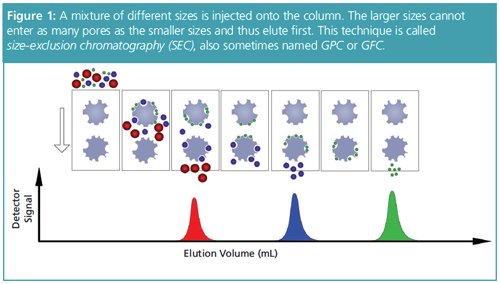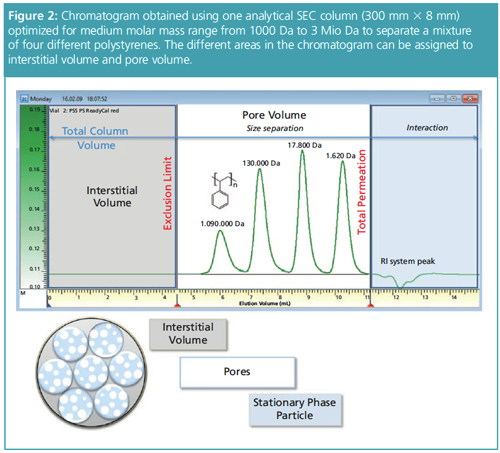Tips & Tricks GPC/ SEC: What Are the Differences Between GPC, SEC, and GFC, and How Do You Get Started with the Technique?
Molar mass distributions, molar mass averages, and polydispersity can be determined by gel permeation chromatography (GPC), size-exclusion chromatography (SEC), and gel filtration chromatography (GFC). This makes this technique indispensable for all scientists in quality control (QC) and R&D who have to work with large molecules. However, the technical terms used can be quite confusing for beginners. This instalment of Tips & Tricks explains more.
Photo Credit: ShpilbergStudios.adobe.com

Molar mass distributions, molar mass averages, and polydispersity can be determined by gel permeation chromatography (GPC), size-exclusion chromatography (SEC), and gel filtration chromatography (GFC). This makes this technique indispensable for all scientists in quality control (QC) and R&D who have to work with large molecules. However, the technical terms used can be quite confusing for beginners. This instalment of Tips & Tricks explains more.
Gel permeation chromatography (GPC), gel filtration chromatography (GFC), and size-exclusion chromatography (SEC) are names used to describe the same liquid column chromatographic technique required to determine important properties of macromolecules, also known as polymers, biopolymers, polysaccharides, or proteins. The separation mechanism behind these names is the same, independent of the abbreviation used. However, scientists with different backgrounds often refer to the technique differently.
The term GPC is mainly used by chemists and scientists who work with synthetic polymers or plastics. Many of those materials are only soluble in organic solvents, so often the term GPC is related to separations in organic solvents in general. One special niche application is high-temperature GPC (HT-GPC), which is required for polyolefins, for example, polyethylene and polypropylene. These materials are only soluble in specific organic solvents at high temperatures above 140 °C, therefore requiring special columns and instrumentation.
The term GFC is often used by biologists or scientists who have to purify or separate biological molecules. This generally requires an aqueous mobile phase and so the term GFC is often used for separations in aqueous solvents. However, there are separations in water that are also addressed as GPC, for example, for polyacrylic acid, a water-soluble synthetic polymer.
SEC is the name that describes the chromatographic process best and thus includes, in a way, both GPC and GFC. SEC implies that (large) molecules are sorted by their size, independent of the solvent used and the way the macromolecule is produced or obtained.
The size separation step occurs in a column filled with porous particles (stationary phase) and is an entropic driven process. The sample is dissolved in a solvent-which is also used as a mobile phase in the chromatographic process- and is injected onto the column. Here larger sizes are excluded from penetrating the pores in the stationary phase particles while smaller sizes can enter and are thus delayed on their way through the column. Figure 1 illustrates this process.

The origins of SEC can be traced back to 1959 when Porath and Flodin used commercial cross-linked polydextran gels to separate macromolecules in an aqueous medium (1). In 1964 Moore performed the first separations in organic solvents using cross-linked polystyrene stationary phases (2). Since then new polymer- and silica-based stationary phases have been developed to allow for optimized separations in medium polar solvents (3). High resolution and fast separations are achievable by using optimized particle sizes (4).
The analysis goals in modern SEC applications are very diverse and range from purification to quality control and determination of structure-property relationships where molar masses, composition, branching, or end groups are determined. The wide applicability and the fact that SEC can be easily automated has made SEC one of the most important techniques for measuring properties of synthetic and natural macromolecules.
How To Get Started Implementing SEC
Dedicated SEC equipment is available as complete turn-key systems that include all the required components. If liquid chromatography (LC) equipment is available, it is sometimes possible to transform a high performance liquid chromatography (HPLC) system into a SEC system by changing a few important components.
However, scientists should always keep two important points in mind:
- SEC solvents dissolve polymeric materials. It is important to make sure that all HPLC components (including all plastic tubing, seals, frits) are not attacked or dissolved by the SEC solvent. Please refer to the user manual to avoid damaging equipment.
- Polyolefins and all materials, which are only soluble at higher temperatures in specific solvents, require dedicated HT instruments.
If HPLC components are to be used, different columns are required. However, scientists should also carefully review the pump requirements, the injection system, the detection options applied, and the software used. As the separation columns are the heart of any SEC system, these will be discussed first. Detection options, software considerations, and other major differences between HPLC and SEC will follow.
Column Considerations (5)
Column selection is the most crucial part for successful SEC analysis, and although method development is generally considered easy (no gradients are used, just one solvent is applied as mobile phase) it is important to pay attention to the details.
Just like HPLC columns, SEC columns are defined by their dimension (length [l] and internal diameter [i.d.]), the size of the particles in the column (given in μm units), and the stationary phase material. Typical SEC stationary phases are either polymer-based or silica-based. The polarity of the stationary phase should be similar to the polarity of the sample and solvent to ensure a pure size-based separation and to suppress undesired interactions.
Compared to HPLC columns typical SEC columns have a larger internal diameter and are longer. Typical internal diameters are approximately 8 mm for analytical columns. The internal diameter range is between 2.1–4.6 mm (semi-micro SEC) and 20–40 mm (preparative SEC). Lengths vary from 150 mm (semi-micro) to 250–300 mm (analytical) or even 600 mm for some older applications. As in HPLC, the particle size is one factor that influences the resolution. The smaller the particle size, the higher the resolution; however, not all particle sizes are applicable for all applications.
Of utmost importance for SEC columns is the size of the pores in the particles (often given in Å units). This size determines the molar mass separation range. Often not just one SEC column is used but several columns are combined into a column bank (or a column set) to increase the molar mass separation range and the resolution.
The analysis time for a SEC run on one traditional analytical column is approximately 15 min assuming a typical flow rate of 1 mL/min. If more columns are used, the analysis time increases linearly. Figure 2 shows a typical chromatogram obtained for a mixture of four polystyrenes with different molar masses. It also illustrates how the different parts in the column contribute to the chromatogram. The white area assigned to pure size separation in the pores is the area where molar mass distributions can be determined. Molecules eluting in the interaction area are often small molecules such as additives or residuals from the production. They can be identified and quantified just as in HPLC separations.

Detector Considerations (6)
Every SEC system requires at least one concentration detector. While some naturally occurring macromolecules (for example, proteins) can be detected using UV–vis detectors, many other macromolecules lack chromophores and are thus invisible to UV–vis and diode array detectors. It is good practice to review if the samples and calibrants to be used are UV–vis detectable and if the existing detection options are sufficient.
One advantage of SEC is that it is an isocratic technique and allows the use of the universal refractive index (RI) detector. This detector can detect all kinds of samples and is the detector of choice for the vast majority of all organic SEC separations.
Modern SEC instruments are often equipped with several detectors in a detector train, as the combination of these detectors lends true value to SEC. Multi-detection turns SEC into a powerful technique for comprehensive characterization of macromolecules. Light scattering and viscosity detectors are quite common additions. Hyphenation with spectroscopy or mass spectrometry can also be applied.
Software Considerations
Scientists dealing with macromolecules often look for very specific information. In general, they need molar mass averages (often easier to determine) and molar mass distributions (7).
SEC is a relative method and requires calibration. The calibration procedure in SEC is very different to HPLC. Calibration of SEC columns is based on assigning a retention volume to a molar mass. The area of the detector response peak is initially of secondary importance. This is opposite to HPLC procedures, which rely on calibrating and assigning a concentration to a detector response (signal intensity, peak area).
While comparisons within the same laboratory do not require any special routines in the software, the unique SEC calibration processes and the determination of the molar mass distribution certainly do. If results between different laboratories are to be compared, or pharmacopeias are to be followed, or absolute molar masses and branching are to be determined with proper slice lists and registration data, then standard chromatography data systems (CDS) often lack proper and easy-to-use SEC functionality. Thus, specific GPC/SEC software is needed to generate the results.
Other Things to Think About
As mentioned previously, SEC is an isocratic technique. Gradient pumps can be used but do not offer advantages. Isocratic pumps are suitable for SEC and sometimes even provide better performance because they are optimized to provide a stable flow rather than a stable gradient. In HPLC, the retention volume of a peak is used for identification purposes and stable flow is important. However, small variations can be tolerated. In SEC, the retention volume is used to calculate the molecular weight and the relationship is logarithmic, so stable flow is critical. Degassers are often useful accessories that hinder bubble formation in pumps.
Typical HPLC column compartments are designed for use with just a pre-column and a 25-cm HPLC analytical column and are therefore often much too small to accommodate SEC columns and SEC column sets. A spacious SEC column compartment is particularly required when using solvents with higher viscosity.
Injection volumes in SEC can be quite different from the options that the existing autosampler or manual injector offers. Volumes of 20–100 μL are typical for analytical SEC setups. Micro columns or preparative columns use smaller or higher volumes.
Last but not least sample preparation is an issue when starting with SEC. Very often the sample dissolution process is time-consuming and scientists should be aware that very high molar masses can be fragile. Under no circumstances should ultrasonification be used because this can destroy molecules (8).
Summary
- GPC, GFC, and SEC are names interchangeably used to describe the same liquid column chromatographic technique. SEC is the most descriptive term and should thus be preferred.
- There are major differences between SEC columns and HPLC columns. The pores in SEC columns are of utmost importance. To achieve sufficient
- resolution several columns are often combined.
- HPLC equipment can be used. However, scientists need to review if the components can handle SEC solvents and if existing detectors are applicable. In addition, the software should be evaluated to ensure that calibration and evaluation routines are present.
- Polyolefins cannot be analyzed on standard HPLC equipment but require specific HT-GPC instrumentation.
References
- J. Porath and P. Flodin, Nature183, 1657 (1959).
- J.C. Moore, Journal of Polymer Science A 2, 835 (1964).
- P. Kilz, G. Reinhold, and C. Dauwe, Proc Intern. GPC Symp 2000 (Waters, Milford, USA, 2001).
- E. Uliyanchenko, Analytical and Bioanalytical Chemistry406(25), (2014).
- PSS e-book 2/5: GPC/SEC Columns, 2018 (contact the author to receive a free pdf copy).
- PSS e-book 3/5: GPC/SEC Detection, 2018 (contact the author to receive a free pdf copy).
- D. Held, The Column3(8), (2007).
- G. Reinhold, The Column7(15), 13–17 (2011).
Daniela Held studied polymer chemistry in Mainz, Germany, and works in the PSS software and instrument department. She is also responsible for education and customer training.
E-mail: DHeld@pss-polymer.com
Website: www.pss-polymer.com

Understanding FDA Recommendations for N-Nitrosamine Impurity Levels
April 17th 2025We spoke with Josh Hoerner, general manager of Purisys, which specializes in a small volume custom synthesis and specialized controlled substance manufacturing, to gain his perspective on FDA’s recommendations for acceptable intake limits for N-nitrosamine impurities.













